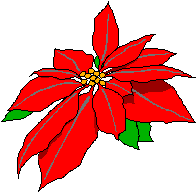THE POINSETTIA STORY
Las Flores de Noche Buena
by Bob BrookeMay you and yours find happiness this holiday season.
The bright red flowers of the poinsettia have come to symbolize Christmas for many people. But it's association with Christmas is a relatively recent phenomenon. In fact, it was once used to treat fevers by the Aztecs in central Mexico.
The Aztecs called poinsettias cuetlaxochitle. Native to Central America, the plant flourished in an area of southern Mexico known as Taxco del Alarcon. Not merely decorative, the Aztecs put the plant to practical use. During the 14th through the 16th century, they used the milky white sap to control fevers and the bracts (what most people call flowers) to make a reddish-purplish dye to use in making textiles and cosmetics. Moctezuma, the last of the Aztec kings, had poinsettias brought into what is now Mexico City by caravans because poinsettias couldn't be grown at that high altitude.
The poinsettia may have remained a regional plant for many years had it not been for the efforts of Joel Roberts Poinsett. The son of a French physician, President James Monroe appointed him as the first U.S. Ambassador to Mexico in 1825. Poinsett, later founder of the Smithsonian Institution in Washington, DC, had attended medical school himself, but his real love in the scientific field was botany. While visiting the Taxco area in 1828, he became enchanted by the brilliant red blooms he saw there. He immediately sent some of the plants back to South Carolina, where he began propagating them and sending them to friends and botanical gardens.
Among the recipients of Poinsett's gift plants was John Bartram of Philadelphia, who in turn gave the plant over to another friend, Robert Buist, a Pennsylvania nurseryman, thought to be the first person to have sold the plant under its botanical name.
Later, William Prescott, a historian and horticulturist who had just published a book, The Conquest of Mexico, in 1836, gave the plant the name we know today. In it he detailed Poinsett's discovery of the plant. So Prescott named the plant the poinsettia in honor of Poinsett's discovery.
There's a legend associated with many religious symbols in Mexico. And so it is with the poinsettia. Legend says that Pepita, a poor Mexican girl, had no gift to present the Christ Child at Christmas Eve mass. As Pepita walked slowly to the chapel with her cousin Pedro, sadness filled her heart. Not knowing what else to do, Pepita knelt by the roadside and gathered a handful of common weeds, fashioning them into a bouquet. Looking at the scraggly weeds, she felt more saddened and embarrassed by the humbleness of her offering, but felt her spirit lift as she knelt to lay the bouquet at the foot of the nativity scene.
Suddenly, the bouquet of weeds burst into blooms of brilliant red, and all who saw them were certain that they had witnessed a Christmas miracle. From that day on, the bright red flowers were known as Las Flores de Noche Buena, or Flowers of the Holy Night, for they bloomed each year during the Christmas season.
But, here in the U.S., a nurseryman named Albert Ecke can be credited with making the poinsettia the Christmas symbol it is today. Ecke's son, Paul, believed that the poinsettia would make an ideal official holiday flower. But his challenge was how to promote and market a plant that most people had never heard of or even seen.
So Paul began producing field-grown blooming plants, which he sold at roadside stands in the Hollywood and in the Beverly Hills area. As Hollywood became developed, it became necessary for the Eckes to find other land on which to grow their poinsettias. Their search ended in the little town of Encinitas, approximately two hours south of Los Angeles, which offered a climate that was mild year-round, nearly identical to that in which the native Mexican plants grew wild, as well as a good water supply. Paul moved the Ekes ranch to Encinitas in 1923. Early poinsettia varieties weren't particularly adaptable to a greenhouse growing environment. They were leggy, easily lost their colored bracts, and tended to fade quickly outside of the controlled environment of the greenhouse.
But in 1963 developments in poinsettia breeding yielded the first commercial-quality plants. At the same time, Paul's son, Paul Ecke Jr.,joined his father in the business. With formal training in horticulture from Ohio State University, Paul Jr. recognized the advantages of the changing nature of the business. He encouraged his father to move toward greenhouse culture. Though skeptical of such a radical change, Paul Sr. agreed, and the family began building greenhouses. By the mid-1960s, most of the Ranch's commercial growing operations had shifted from the field to the greenhouse.
The rest, as they say, is history.
Feliz Navidad Buono Natale Joyeux Noel
Glucklich Weihnachten Merry Christmas
